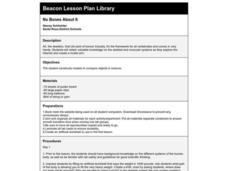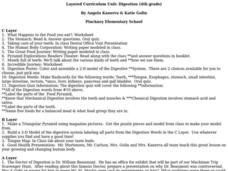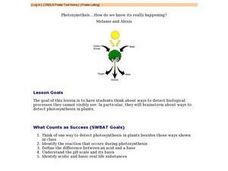Curated OER
Animals and Humans
Young scholars identify the functions of various body parts. They participate in the "Head, Shoulders, Knees, and Toes" song, draw a picture of themselves and other mammals, and create a traced outline of their body that they add...
Curated OER
My Body
First Graders practice using the names of body parts by finding pictures and placing them in the correct position on a life-size outline of a human body. These type of hands-on lessons are one of the best ways for young learners to truly...
Curated OER
Body Parts in Hebrew
Students, after practicing with an extensive vocabulary list of body parts in Hebrew, identify those parts on a poster of a human figure. They practice writing and saying their vocabulary words daily during class instruction.
Curated OER
From Human Skeletons to Owl Pellets to Paleontology
Students explore about the function of the skeleton and comprehend the names of the bones of the human skeleton. They compare bones of the human skeleton to a dinosaur skeleton and graph to compare these bones. Students sort bones to...
Curated OER
Body Systems
In this body systems lesson, students work in small groups conduct research to become an 'expert' on one of the 7 body systems. Students present their findings to the class via power point, poster, or song.
Curated OER
No is No, Si is Yes
Third graders match the body part words in Spanish to a picture. They receive a picture of a human with lines coming from its feet, hands, and arms. Students use a word bank, to write the Spanish word that corresponds to the picture. ...
Curated OER
All's Well for Stem Cells
By exploring the latest research on cell and tissue renewal your young scientists can understand the various internal body parts and systems examined in these studies.
Curated OER
Circulatory Circles
Students investigate the circulatory system. In this circulatory system lesson, students complete a WebQuest and explore all the areas of the heart. Students determine the functions of different parts of the circulatory system and...
Curated OER
Healthy Heart
Students discover the power of their heart and provide an opportunity to talk about ways to maintain good health. In this early childhood heart lesson, students diagram a human heart, identify exercises that promote a healthy heart, and...
BBC
Ourselves
Young biologists identify parts of the body, sort humans from other animals, and list the difference they see. Learners are split up into groups of three, and each group must find pictures in magazines of humans and other animals. They...
Curated OER
The Skeletal System
Young scholars research the skeletal system. In this anatomy lesson, students measure their bodies to find the approximate length of their bones. They draw and cut out each of the bones and then attach them using brads or glue.
Curated OER
No Bones About It
Young scholars conduct Internet research on the different parts of the skeletal system. Then they create a model arm that demonstrates how muscle and bone work together to create movement.
Curated OER
Digestion
Fourth graders answer the question what happens to the food you eat? They complete a worksheet about the food you eat. They discuss the different types of teeth that we have. Students complete digestion poster in which they color and...
Curated OER
Digestion & Nutrition: a Case Study
Students explore digestion/nutrition and utilize scientific investigation skills. They complete meal logs for several days and graph their results. After analyzing their data, they write formal lab reports.
Curated OER
Feed Me, Seymour
Students work in small groups to create posters illustrating the major facts and functions of plant organs. Within their groups, they assume the role of specialists creating specialized posters pertaining to the different parts of plants.
Curated OER
Talk to the Hand
Students explore the significance of various body parts in artistic and social expression. They research a body part and create a museum installation depicting the artistic and social significance of the body part throughout history.
Curated OER
Fish Fashion 101
Students explore fish anatomy. In this fish anatomy and adaptation lesson plan, students define and identify the location of fish body parts. Students add these parts of a fish's anatomy to a life-sized fish costume worn by a...
Curated OER
Keeping Your Heart in Good Shape: What are the Benefits? - Biology Teaching Thesis
Students name the main parts of the heart and what events occur there. They write a reaction that contains complete sentences, and uses proper spelling and grammar, after viewing a video. Students define the following terms: contraction,...
Curated OER
Photosynethsis....How do we know it's really happening? - Biology Teaching Thesis
High schoolers think of one way to detect photosynthesis in plants besides those ways shown in class. They identify the reaction that occurs during photosynthesis. Students define the difference between an acid and a base. They identify...
Curated OER
Animal Signs
Students discuss the many different types of animal signs that can be used to identify and track animals. They participate in an hands-on activity in which they examine tracks, trails, homes, territory markings, and even "scat" left by...
Curated OER
Performing the Heimlich Maneuver
Students perform the Heimlich Manuever. In this first aid lesson, students read about choking and the Heimlich Maneuver. Students learn when and how to perform the Heimlich Maneuver.




















